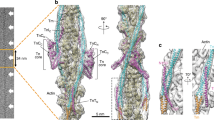2+
concentrations tropomyosin is located at the edge of the thin filament, thereby interfering with the formation of strong actin-myosin linkages (blocked state). An increase in Ca2+ activity causes an azimuthal shift of tropomyosin around the filament (by about 30°), thereby increasing the probability of low-force crossbridge interaction, a process which by cooperative effects induces further tropomyosin movement (by an additional 10°) which results in the open state of the filament characterized by forceful crossbridge interaction. (This mechanism may be analogous to that in ligand-gated ion channels, where ligand binding increases the open probability of the pore.) The extent of activation then depends on the free Ca2+ concentration and on the calcium sensitivity of the thin filament that may be affected by protein phosphorylation, crossbridge attachment, the troponin isoform composition of the filament, and novel calcium-sensitizing drugs that act on the contractile or regulatory proteins and thus increase the force of the heart.
Similar content being viewed by others
Author information
Authors and Affiliations
Rights and permissions
About this article
Cite this article
Rüegg, J. Cardiac Contractility: How Calcium Activates the Myofilaments. Naturwissenschaften 85, 575–582 (1998). https://doi.org/10.1007/s001140050554
Issue Date:
DOI: https://doi.org/10.1007/s001140050554




